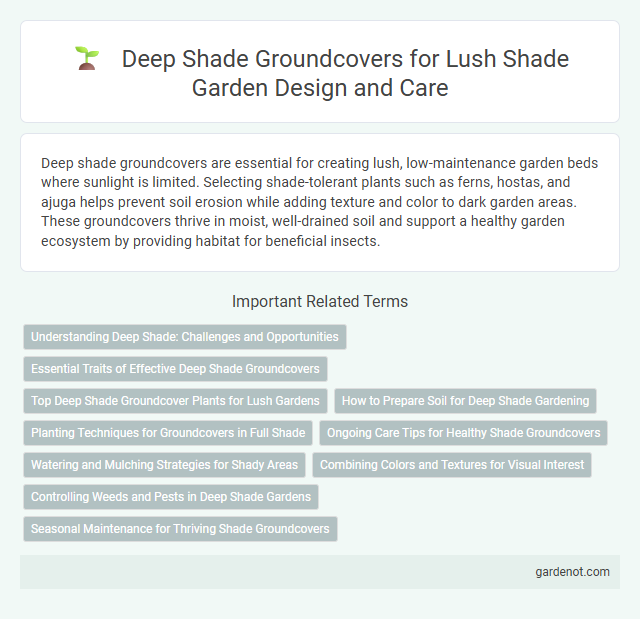Deep shade groundcovers are essential for creating lush, low-maintenance garden beds where sunlight is limited. Selecting shade-tolerant plants such as ferns, hostas, and ajuga helps prevent soil erosion while adding texture and color to dark garden areas. These groundcovers thrive in moist, well-drained soil and support a healthy garden ecosystem by providing habitat for beneficial insects.
Understanding Deep Shade: Challenges and Opportunities
Deep shade environments, characterized by minimal direct sunlight, present distinct challenges for groundcover growth due to limited photosynthesis and moisture retention. Selecting shade-tolerant species such as ferns, hostas, and ajuga can maximize soil protection, reduce erosion, and enhance biodiversity in these low-light areas. Understanding microclimate variations within deep shade zones allows for optimizing plant health and groundcover density, transforming challenging spaces into thriving garden features.
Essential Traits of Effective Deep Shade Groundcovers
Effective deep shade groundcovers thrive with key traits such as tolerance to low light levels, ability to retain moisture, and resistance to common shade-related pests and diseases. Species like Pachysandra terminalis and Vinca minor exhibit dense growth habits, which suppress weeds and enhance soil stability in shaded gardens. Furthermore, these groundcovers provide year-round interest through evergreen foliage and occasional blooms, contributing to a lush, low-maintenance landscape under dense tree canopies.
Top Deep Shade Groundcover Plants for Lush Gardens
Top deep shade groundcover plants such as Pachysandra terminalis, Vinca minor, and Lamium maculatum thrive in low-light environments, offering dense, evergreen foliage that suppresses weeds and stabilizes soil. These plants provide lush green carpets under dense tree canopies, enhancing garden aesthetics while requiring minimal maintenance. Selecting species with varying leaf textures and seasonal blooms ensures year-round interest and biodiversity in deep shade garden beds.
How to Prepare Soil for Deep Shade Gardening
Preparing soil for deep shade gardening requires enriching it with organic matter such as compost or well-rotted leaf mold to improve moisture retention and nutrient availability. Soil should be tested for pH, ideally maintained between 6.0 and 7.0, and amended with lime or sulfur as needed to optimize conditions for shade-loving plants. Adequate drainage must be ensured by loosening compacted soil to promote root growth and prevent waterlogging in the dense canopy environment.
Planting Techniques for Groundcovers in Full Shade
Selecting shade-tolerant groundcovers like Pachysandra terminalis, Vinca minor, and Tiarella cordifolia ensures robust growth in deep shade. Planting techniques involve preparing well-drained, organic-rich soil and spacing plants adequately to promote air circulation and prevent fungal diseases. Regular mulching helps retain moisture and suppress weeds, creating optimal conditions for groundcovers to thrive in full shade environments.
Ongoing Care Tips for Healthy Shade Groundcovers
Deep shade groundcovers require consistent moisture retention through mulching and regular watering to thrive in low-light environments. Periodically removing debris and fallen leaves prevents mold growth and maintains air circulation essential for plant health. Fertilize with a balanced, slow-release formula in early spring to support vigorous growth throughout the growing season.
Watering and Mulching Strategies for Shady Areas
Deep shade groundcover thrives with consistent, moderate watering that maintains moist but well-drained soil to prevent root rot and fungal diseases common in low-light conditions. Applying a 2-3 inch layer of organic mulch, such as shredded bark or compost, conserves soil moisture, regulates temperature, and suppresses weeds around shade-loving plants like hostas, ferns, and ajuga. Mulching also improves soil structure and nutrient availability, promoting healthier growth in the often-dry understory of dense tree canopies.
Combining Colors and Textures for Visual Interest
Deep shade groundcovers such as hostas, ferns, and ajugas create a rich tapestry by combining varying shades of green, purple, and silver foliage that thrive in low light. Layering plants with different leaf textures, from the smooth, glossy leaves of pachysandra to the feathery fronds of ostrich ferns, enhances depth and visual intrigue. Strategic grouping of these contrasting colors and textures transforms dull, shadowy garden areas into vibrant, eye-catching landscapes.
Controlling Weeds and Pests in Deep Shade Gardens
Choosing deep shade groundcovers like Pachysandra terminalis or Vinca minor effectively suppresses weeds by forming dense mats that block sunlight. These plants reduce pest habitats by minimizing exposed soil and maintaining consistent moisture levels, which discourage common pests such as slugs and aphids. Regular monitoring and selecting disease-resistant varieties further enhance the control of weeds and pests in deep shade garden environments.
Seasonal Maintenance for Thriving Shade Groundcovers
Deep shade groundcovers such as pachysandra, sweet woodruff, and hostas require seasonal maintenance to thrive and maintain dense foliage. Pruning in late winter or early spring removes old growth and encourages fresh shoots, while mulching with organic material helps retain moisture and suppress weeds during the growing season. Regular monitoring for pests and diseases combined with occasional fertilization supports healthy, vibrant groundcover even in the darkest garden areas.
Deep shade groundcover Infographic

 gardenot.com
gardenot.com